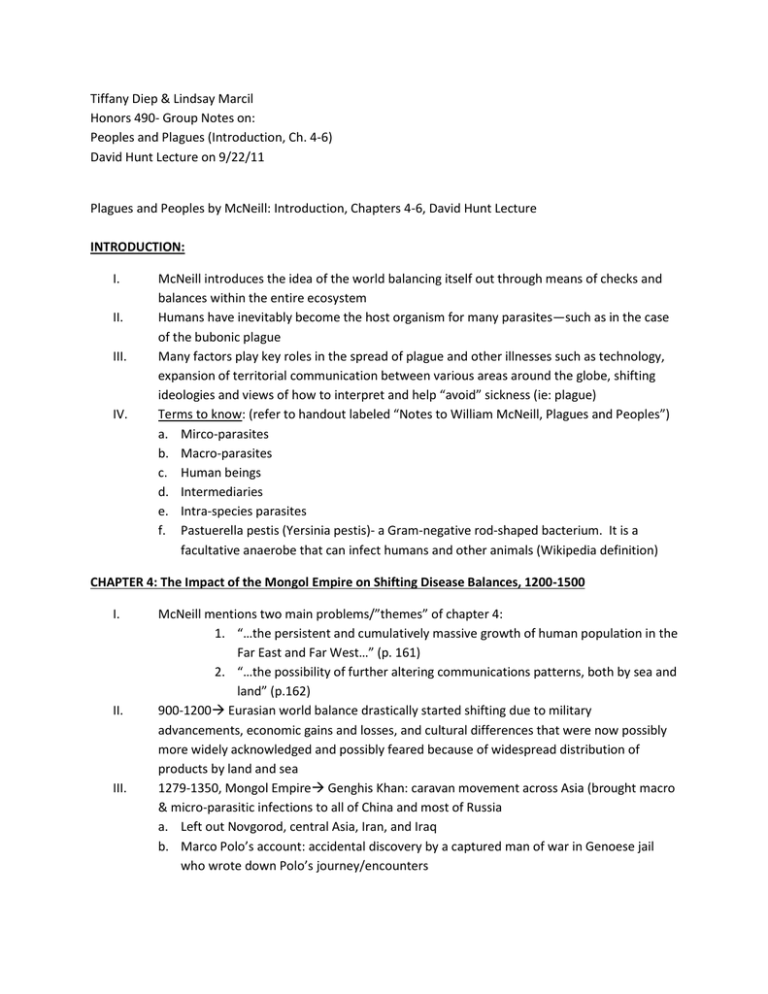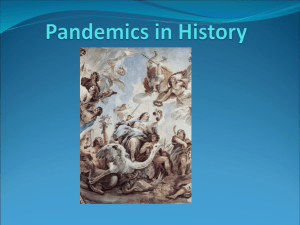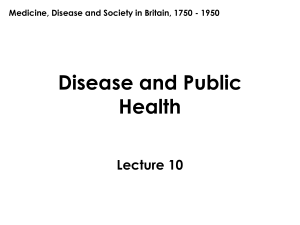Tiffany Diep & Lindsay Marcil Honors 490
advertisement

Tiffany Diep & Lindsay Marcil Honors 490- Group Notes on: Peoples and Plagues (Introduction, Ch. 4-6) David Hunt Lecture on 9/22/11 Plagues and Peoples by McNeill: Introduction, Chapters 4-6, David Hunt Lecture INTRODUCTION: I. II. III. IV. McNeill introduces the idea of the world balancing itself out through means of checks and balances within the entire ecosystem Humans have inevitably become the host organism for many parasites—such as in the case of the bubonic plague Many factors play key roles in the spread of plague and other illnesses such as technology, expansion of territorial communication between various areas around the globe, shifting ideologies and views of how to interpret and help “avoid” sickness (ie: plague) Terms to know: (refer to handout labeled “Notes to William McNeill, Plagues and Peoples”) a. Mirco-parasites b. Macro-parasites c. Human beings d. Intermediaries e. Intra-species parasites f. Pastuerella pestis (Yersinia pestis)- a Gram-negative rod-shaped bacterium. It is a facultative anaerobe that can infect humans and other animals (Wikipedia definition) CHAPTER 4: The Impact of the Mongol Empire on Shifting Disease Balances, 1200-1500 I. II. III. McNeill mentions two main problems/”themes” of chapter 4: 1. “…the persistent and cumulatively massive growth of human population in the Far East and Far West…” (p. 161) 2. “…the possibility of further altering communications patterns, both by sea and land” (p.162) 900-1200 Eurasian world balance drastically started shifting due to military advancements, economic gains and losses, and cultural differences that were now possibly more widely acknowledged and possibly feared because of widespread distribution of products by land and sea 1279-1350, Mongol Empire Genghis Khan: caravan movement across Asia (brought macro & micro-parasitic infections to all of China and most of Russia a. Left out Novgorod, central Asia, Iran, and Iraq b. Marco Polo’s account: accidental discovery by a captured man of war in Genoese jail who wrote down Polo’s journey/encounters IV. V. VI. VII. VIII. IX. First major hypothesis arose between 1921-24 when international team of epidemiologists studied the human plague outbreak in Manchuria a. 1890s Don-Volga regions of southern Russia, rodent species carried plague identified by the bacillus Pasteurella pestis to Eurasian steppe 1. war zones created cause for transmission of the bubonic infection via travelling troops A somewhat messy timeline is displayed in McNeill’s 4th chapter of the places affected by plague… Question: Why is this? Does the scattered timeline serve a purpose? “…long-standing grievances of poor against rich often boiled to the surface. Local riots and plundering of private houses sometimes put the social fabric to a severe test” (p. 182). a. McNeill points out that plague not only disrupted health-related issues but socioeconomic ones as well—feeding into the even greater distance between the poor and the rich 1. Leprosy was seen as a revered disease that struck the poor. Interestingly, the decline of leprosy and other skin-related diseases was often thought to have disappeared with the overwhelming numbers of those dying of plague. However, this proved problematic because Hansen’s disease continued to exist after 1346. 2. Note: Wool production may have also contributed to the decrease in leprosy in the 1400s 3. Question: Do you think it was a direct link between the production and use of wool that decreased the incidence of leprosaria, or was it the fact that economic and lifestyle changes were starting to arise? Quarantine: compulsory isolation, typically to contain the spread of something considered dangerous, often but not always disease. The world comes from the Italian (seventeenth century Venetian) quarantena, meaning forty-day period. Quarantine can be applied to humans, but also to animals of various kinds (wiki definition). a. This method was often used in order to keep uninfected persons safe from those infected with plague Psychological and cultural issues varied in reactions among Europeans. Some searched for groups of peoples to blame, others searched for answers in god, or agricultural growth and distribution of products among a wider range of expansion and economic/political growth a. Deepened cultural differences among Christian-based countries and Moslem countries ensued widening the gap of feelings of suspicion and demographic importance among the separation of “different kinds of people” Concluding Thoughts: fourteenth century major decline in populations in the Far East and Far West a. Several diseases MUST have contributed to this population decline (it is still a very messy web to discern what factors led to such population decrease) b. McNeill’s fourth chapter builds up the background knowledge needed to enter into the reasons behind why epidemiological consequences are important in the following chapters c. Question: Do you agree with the above statement? Do you think McNeill’s denselydetailed Chapter 4 was a good “build up” to his following chapters? Do his statistics match up with his hypothesis? CHAPTER 5- Transoceanic Exchanges, 1500-1700 I. II. III. IV. V. VI. McNeil writes that the New World (America) is no more than an enormous island in the 1500s. a. “Forms of life in were, in general, more highly evolved in Eurasia and Africa, having responded to a wider range of variability arising in the larger land mass” (p. 176). b. Amerindian disease was undeveloped causing their inhabitants to be more vulnerable. It is hard to say whether disease was present in America before Columbus. Some believe that America is the origin of syphilis but this can’t be confirmed. Indications of Aztec codices have been found, but there also isn’t any evidence of it being caused by human-to-human infections. (p. 177) People in Mexico and Peru were “victims, on a mass scale, of the common childhood diseases of Europe and Africa”(p. 178). a. By 1568: population of Mexico was 3 million (1/10 of what it used to be) b. Population of Cayapo in 1903: 6000-8000; Population in 1918: 500; Population in 1927: 27; Population in 1950: 2-3; (p. 181) c. Mandan tribe population went from 2,000 to 30-40 in two weeks When 90% of the population is lost, “faith in established institutions and beliefs cannot easily withstand such disaster; skills and knowledge disappear” (p. 181). It also results in labor shortage and economic retrogression. 1520: The Spaniards brought smallpox from Spain to Mexico and Guatemala. a. McNeil emphasizes two points: i. “Spaniards and Indians agreed that epidemic disease was a particularly dreadful and unambiguous form of divine punishment” (p. 183). ii. “Spaniards were nearly immune from the terrible disease that raged so mercilessly among the Indians” (p. 184). 1. Spaniards always prevailed despite their disadvantages in numbers because they were immune to disease. b. Throughout the 16th and 17th century, the Amerindian population was exposed to diphtheria, mumps, smallpox and measles. Unlike Eurasians, Amerindians had not developed resistance to such diseases. c. Quote by German missionary in 1699: “The Indian die so easily that the bare look and smell of a Spaniard causes them to give up the ghost” (p.186). Tropical regions of the New World provided ideal conditions for African diseases such as malaria and yellow fever to establish themselves. a. Species of mosquitos called Aedes aegypti carried malaria from West Africa. Also known as “Yellow Jack,” it was able to survive on shipboard for weeks and was just as lethal to Europeans and Amerindians. VII. VIII. IX. b. African populations in the 19th century surged in the Caribbean Islands because they had developed immunity. Syphilis and typhus appeared in Europe during the Italian Wars (1494-1559). a. Syphilis moves from host to host through mucous membranes of sex organs. b. Typhus became a disease of the poor due to overcrowding of undernourished people. c. “English sweats” appeared in England suddenly in 1485 then disappeared suddenly disappeared in 1551. It was a disease of the upper class. Older individuals have more immunity than younger people due to prior exposures (p. 197). Intensified efforts at public sanitation and the increase in available crops forestalled disaster from diseases. a. American crops such as maize, potatoes, tomatoes, chili peppers, peanuts, and manioc became available to Eurasia and Africa, preventing nutrient deficiencies. CHAPTER 6: The Ecological Impact of Medical Science and Organization since 1700 I. II. III. IV. V. “Everyone felt better when self-confident, expensive experts could be called in to handle a vital emergency” (p. 209). a. Doctors had the same knowledge as other folk. They would treat people and cherish the responses “that by some happy chance seems to achieve desired results” (p. 210). b. In Europe, people had a systematic approach where they would observe the symptoms and the course of a disease. “A cure that worked once could be tried again on the next patient, and professional colleagues were on hand to observe the results… ready to accord admiration and respect to the man whose cures worked batter than usual” (p. 210). th 15 Century: Italian doctors designed measures to quarantine plague Smallpox was particularly destructive to Amerindians when they met infections as adults. Many Americans were willing to accept the risks inherent in deliberate inoculation with smallpox. Europeans however, saw this as unacceptable because only small children were likely to die from smallpox. “More animals meant more meat and milk in human diet, and an enlarges supply of protein. This may well have increased human capacities to manufacture antibodies against infection of any and every kind…” (p. 219). a. Enclosing wastelands and open fields also helped to contain herds of infected cattle and sheep. The chain of infection was broken. 1721: Deliberate smallpox inoculations were performed in England. The royal children were successfully immunized the following year. a. The process involved transferring matter from a smallpox pustule into an open wound on a patients skin. The symptoms that resulted were slight, but enough to provide immunity. b. By the 1740s, the practice became widespread in England. VI. VII. VIII. IX. X. XI. XII. XIII. c. The practice mainly took place in small towns and villages because smallpox infected young adults and adolescents. In big cities, smallpox affected infants and went unnoticed. d. There was opposition to smallpox inoculations until the death of Louis XV in 1774. 1763: Lord Jeffrey Amherst order that blankets infected with smallpox be distributes among enemy tribes (p. 222). This was deliberate germ warfare on Indian tribes. 1798: Edward Jenner, an alert English doctor, published findings that cowpox provided immunity to smallpox. The dangers from cowpox were negligible, but still provided the same immunity as inoculation from smallpox pustules seen earlier. (p. 222) a. This method of “vaccination” became widely recognized in Europe. b. 1803: A medical mission form Spain arrived in Mexico to instruct local doctors about the new technique. c. 1807: medical mission departed for the Philippines to educate doctors about the new technique; by this time, the practice was used in the New World. Other methods of “vaccination” may have been used prior to Jenner’s discovery. a. “Smallpox inoculation seems to have been known and practiced at the folk level throughout Arabia, North Africa, Persia, and India” (p. 224). b. “Reports of a more elaborate Chinese method, involving the insertion of a suitable infected swab of cotton inside the patient’s nostril, reached London in 1700” (p. 224). i. Chinese texts mention that this practice may have been used since the 11th century. During Napoleonic wars, more people died form infectious disease than battle. 1845: parasitic fungus established themselves in European potato fields resulting in the widespread failure of potato crops a. Famine, typhus and other diseases resulted causing millions to die. Rising populations along with lack of sanitation reforms in American cities led to a sharp rise in mortality. Cholera: bacillus that could live as an independent organism in water for lengthy periods; survives in stomach juices and swiftly multiplies; a. Symptoms: diarrhea, vomiting, fever and death b. Capable of penetrating any quarantine and chose victims erratically c. 1817: outbreak of cholera in Calcutta d. 1820-1822: Ships carried cholera to Ceylon, Indonesia, SE Asian mainland, China and Japan e. 1826: Second wave of cholera emerged from Bengal eventually invading Russia, Poland, Baltic, England, Ireland, Canada, US, and Mexico. i. Steamships and railroads increased global diffusion of cholera. ii. Cholera deaths totaled millions in the 19th century. Cholera fueled debates of thoughts about epidemics. a. Miasma: since the days of Hippocrates, European doctors thought diseases emerged from dead corpses or other rotting matter XIV. XV. XVI. XVII. XVIII. b. Germ Theory: 1546 by Girolamo Fracastoro; provided theoretical justification for quarantine regulations; lacked empirical base because no one imagined that insects could be carriers of disease (p. 235). 1854: John Snow cholera that broke out in a London district traced to a single contaminates course of drinking water. a. 1880s: microscope discovers “germs”; bacilli of anthrax and TB i. Neither of these infections spread dramatically didn’t upset miasma theory b. 1883: Robert Koch claimed to find bacillus responsible for cholera, proving miasma theory wrong c. 1892: German doctor wanted to prove that germ theory wrong; he drank a beaker full of cholera bacilli and experienced no ill effects (p. 236). i. May be due to increased anger and anxiety causing increase in stomach acid which may have killed bacteria British Navy improvement (p. 237-238) a. Providing citrus juices to provide essential nutrients i. Some species of lime lacked vitamins making its consumption useless; also increased skepticism towards citrus juice in treating scurvy ii. Providing sea-water distilleries to supple fresh water iii. Quarantining new recruits until they have bathed and wear new clothes 1. Reduced typhus dramatically 2. Quinine against malaria; rules to prevent catching malaria Improvements to Prevent Disease (p. 240) a. Establishing Board of Health in major cities b. Installing new systems of water pipes and sewer pipes c. Development of more powerful pumps to deliver water into houses under pressure d. Compulsory elimination of older sewage systems 1883: Robert Koch discovered bacteria causing cholera germ theory!!! a. Chemical disinfectants and heat could kill bacillus b. Careful handling of sufferers could guard against passing disease to others c. 1983: vaccine against cholera developed Provided gateway for other vaccines for common diseases a. Typhoid fever: identified as distinct disease in 1829; effective vaccine developed in 1986; inoculations to test for typhoid fever 1910; b. Diphtheria: bacteria identified in 1883; antitoxin developed in 1891; c. Pasteurization to remove bacteria in milk David Hunt Lecture I. Adding more context to our background knowledge on PLAGUE: Bowdell- historical book on the terrible conditions in early modern Europe (France especially) a. 17th century was a grim period- “Little Ice Age”, uncommonly cold, short growing seasons b. Bad for working populations II. III. IV. V. VI. VII. c. Exploitation rampaging armies, plagues (epidemic diseases) Elites got sick and died young, as well as commoners a. King Louis outlived his son and grandson Epidemics hit the poor harder than the rich (slept in damp houses and on the ground) a. Undernourishment was a key player in the time of plague b. Poor is struck worse than the rich irresponsibility on the side of the officials, king and queen fled from London in 1664, priests said mass in the street, class antagonism c. Question: How, if you think at all, did it help to have class antagonism during such a time of despair? Why as humans are we drawn to needing to find someone or something to blame for illness, disaster, and other negativities of life? 1959 Hunt took- Western Civ course: Master Narrative of European history a. Western civilization created a new kind of human—others were supposed to try harder and run faster b. Americans left college not knowing much about Chinese history (problematic when considering worldly epidemiological causes of illness and massive population declines) 1. Diluted version of the “whole story/picture” if we disregard what is going on world-wide 1970- World history arrived as a newly recognized subfield of discipline a. Question: How did this change the world view of epidemics? Did it even have an impact? Think back to your middle school years history class(es)… Do you feel that you got the “correct” interpretation and/or emphasis of world history? b. First world history text published by McNeill in 1963 c. Most textbooks are now multi-authored (encompassing the history from many angles Asian, Latin, European, African, etc.) How did McNeill build up to Peoples and Plagues? Eurasia’s steppe frontiers: (map charting) a. Arbitrary Ural mountain- not much difference between both populations b. Had to do away with the idea of a boundary between Eurasia (supracontinental land mass) c. We know they are all connected via the study of interconnected language connections McNeill’s thesis: micro-parasites are the heroes of the world (first area affected by plague was in the steppes) disease, blew up special paradigms of how historians thought about people and the world in the past a. Wanted to call into question Enlightenment Optimism (references on p. 263, 291) b. McNeill is unmistakably a conservative. Concept: There are limits to where human reason cannot go. c. Conservative speech in a disastrous mold (78-9) severe economic contraction d. Not wanting to recognize humans having limits! e. So out of touch with how humans think about our world (deliberately provocative), “web of life”, we share the globe with micro-predators, “humanity itself is a disease… constantly killing ecological life” VIII. IX. X. XI. XII. XIII. Military power shaped how the world reacted to illness Japanese kept military soldiers disease-free (p. 288-89) a. Treatment of Asian people intrigued him- Chinese workers were diminished more than just in the work force (peasant workers) b. English peasantry wiped out, as well as mass famines and revolts in 1789 in France Hunt’s personal/academic interest and background knowledge of the time—French Revolution: peasantry life improved a little bit (more land for pasture, raising families, etc.), the idea of a new world was exciting—wanted to raise children in a more “livable world”, draft exemption if you had a child Argument of Old China (McNeill’s view): an admirer of that civilization (Emperors), blocked efforts of bigger peasants to take land from smaller peasants so they could keep paying taxes (kept the cycle of dependence going) Connection between climate and civilization the hotter it is, the more backward it is, the more temperate the climate, the more civilized it is a. Pseudo-science b. Ellsworth Huntington- recruited and organized a group of scholars from around the world to ask them to rate different peoples on a quotient from 0 to 100 for who were the most civilized c. Paradigms of “Southern” streak “The infectious organisms could count on a fresh supply of susceptible children, whose numbers and availability were subject to far smaller statistical variation than had been the case when epidemic patterns of disease produced alternate feast and famine for the organisms infecting humanity” …peaceful coexistence with micro-parasites (p. 233). a. We’ll never win, disease will always win (scientific medicine is also just an altered condition of living) b. Race between skills and ills Closing arguments: “Infectious disease which antedated the emergence of humankind…one of the fundamental parameters and determinants of human history” (p. 295). a. Darwinist with a vengeance- own version of the Garden of Eden (p. 37), web of life was most tightly knit when humanoids were not quite human b. The experience of modern life is compressing in time and space 1. Turn over time is shrinking c. When you broke something, you repaired it… we throw it out (time/space compression—shrinking gap between investment and profit. The rate of change is becoming more and more rapid d. McNeill’s conservatism is too complacent… we need Sartre & Bordell e. Rodent civilization—scary thought!! f. Question: How do the boundaries of the world today shape our perception about life, disease, illness, etc.?






